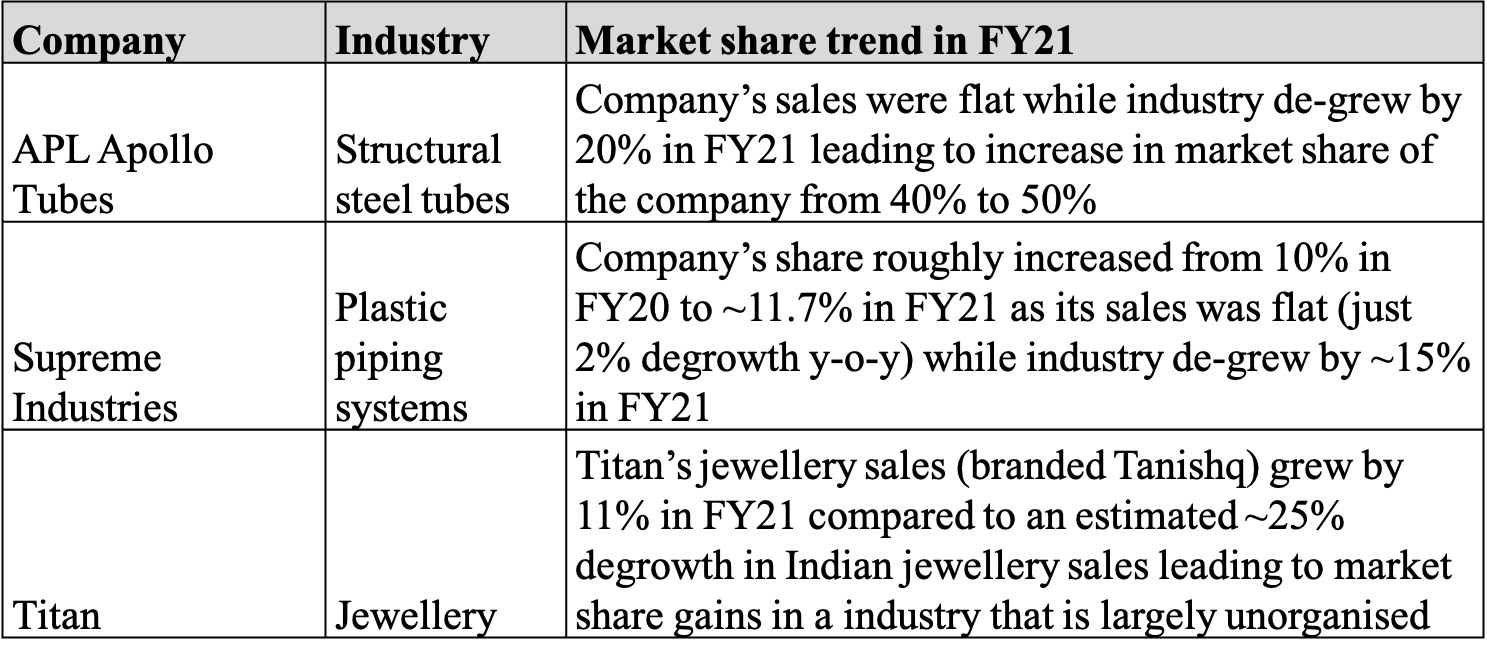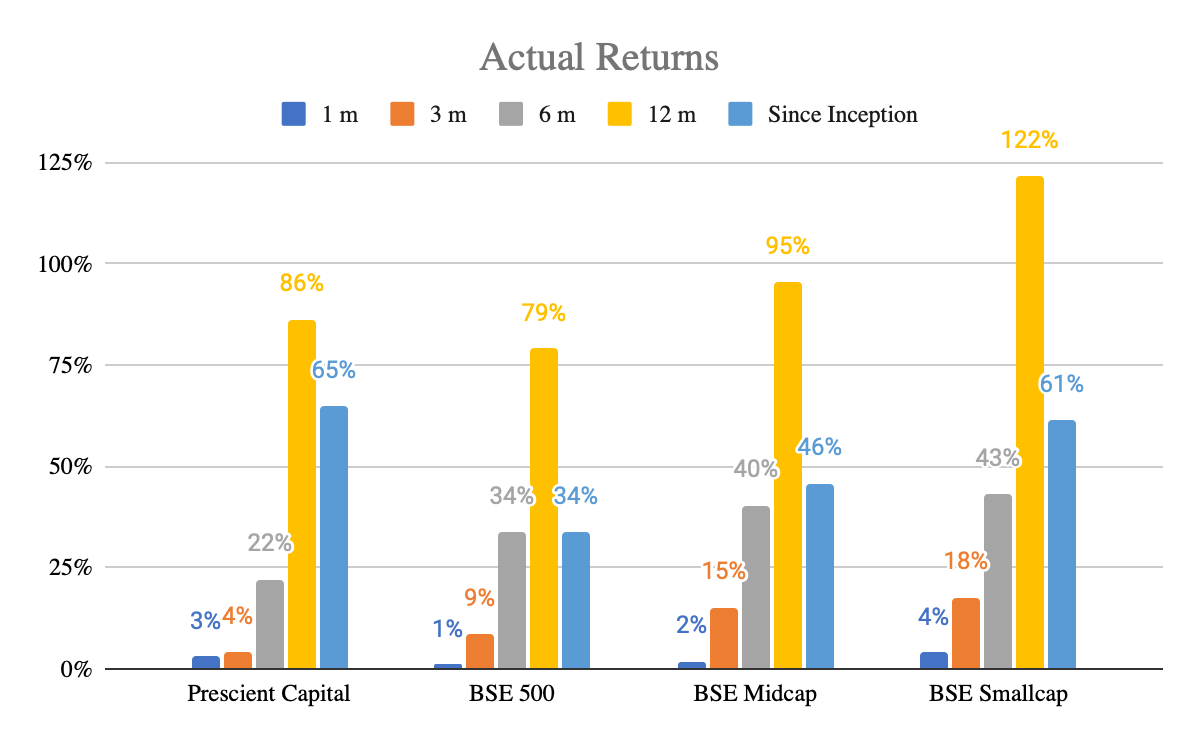Dear Investors,
Hope you and your family are holding up fine.
Below is our performance viz benchmark indices:
In this update we will talk about two topics that some of you have raised in your formal and informal discussions with us:
Topic 1: Investing in IPOs.
We are very excited by the quality of founder/promoters and the companies that are getting listed recently. Especially, some of the tech companies that have filed for their IPOs (Zomato, Nazara, Nykaa, Paytm, Policy Bazaar and Car Trade etc) are unique businesses that we have previously seen as private deals. At Prescient, we have often thought about investing in US tech stocks (for eg: Amazon, Google, Microsoft, Zoom) as these are high growth, sticky businesses with very strong MOATs. These Indian tech IPOs now offer us a more meaningful opportunity to invest in tech businesses given our experience of Indian equity investing help us better track these.
However, the valuations of IPOs in the last 2 years have been expensive to say the least. The chart below summarizes the valuations of companies that have IPOed since 2019:
Average Listing PE
At such valuations, there is more room for downside (due to a macro correction or a bad quarter in a company’s performance). This also puts undue pressure on promoters to generate returns for incoming institutional investors and may trigger a vicious loop for the company. We have often seen businesses not able to match their pre-listing performance for 1-2 years post their listing.
Our criteria for investing is such companies are as follows:
Thorough diligence on the promoters: Due to their limited public track record, more time needs to be spent on the governance track record of the founders/promoters. Collection of both subjective and quantitative data on these promoters becomes critical. As a part of our diligence on these companies, we speak with funds/investors who have been with these companies for the longer term and understand the promoter’s motivation reasonably well.
Amongst the tech businesses, we like those that spend more capital on customer retention/product R&D than on pure customer acquisition. Platform businesses built with such R&D and customer centricity have very high customer retention.
We stay away from valuing on Price to Sales or Price to GMV multiples and work hard to model some sort of future profitability and cash flows and then value on forward P/E or Price to Cash Flow multiple. Given that a lot of value of such businesses is from its high growth trajectory, we focus on the sustainability of the high growth of these businesses 2-3 years hence. We like to invest in business closer to a PEG (Price to Growth multiple) of 1x.
If we can’t invest at the time of IPO, we wait for good quality companies to correct reasonably due to market correction or a temporary blip in their performance. We believe that good companies provide you with a narrow window of opportunity to get in and hence our work should be done before this correction. We have built partial positions in the companies in our portfolio post their corrections.
Heranba: Initiated purchase at a P/E multiple of 19x when the stock corrected by ~ 25% post its listing in Feb 2021
Mrs Bector Foods: Initiated purchase at a P/E of 31x when the stock corrected by ~ 45% post its listing in Dec 2020
Nazara: Initiated a position at a correction of ~25% post its listing in March 2021.
Our balance position gets built based on the performance of these companies or on a sharp correction in the markets.
Topic 2: Portfolio Construct
The second topic we want to discuss today is the construct of our portfolio. A lot of you have often asked us if it is a good time to invest/invest more given the valuation for the index. We would like to answer this by highlighting that we are bottoms-up investors and are very conservative on valuation. As long as we find investable companies in their bottom 20-30% percentile valuation, we will continue to invest. The chart below highlights our model portfolio PE multiple and compares the same to the PE of the BSE Sensex.
Key comments we want to make are:
We typically take 6-9 months to fully deploy your capital. This period factors in any up/down movement in the market. Due to our conservative pace of investment, our older client accounts were 40-60% invested before the March 2020 correction. Our deployment was maximum during the March 2020 quarter when the valuations were at their rock bottom. The availability of cash helped us invest the capital at the right valuation when the time came in March 2020. We believe that small/big corrections are part of the course of this deployment cycle.
If you see our portfolio PE multiple, we have always stayed conservative even when compared to the BSE Index. Individual companies in our portfolio have been selected at conservative valuation. Staying conservative on valuation always gives us a headroom for returns and multiple expansion even when the markets are peaking. If you see the chart above, post March 2021, the index PE has shrunk by ~ 12% whereas our portfolio PE has expanded by ~5%.
As we see things today, we are actively selling companies in our portfolio that are richly valued (>30-40x PE depending on the sector) and do not have promising growth prospects in the next 1-2 years. These names are replaced by well managed companies that are reasonably valued and have better growth prospects for the near term. You would also see that our median portfolio PE has reduced between June 2021 and now. This is the numerical evidence of this portfolio churn we are undertaking.
In case you invest in other PMSes or funds, a metric that you can track and compare is the portfolio PE. A low portfolio PE compared to index / market PE helps protect the downside of your portfolio during market corrections. When we started in the Oct-Dec 2019 period, our portfolio PE was 15x compared to a PE of 26x for the index. During the March 2020 correction, the index corrected by 31% compared to a correction of 20% in our portfolio’s valuations.
Regards,
Prescient Capital
Contact us: https://www.prescientcap.com/contactform













































